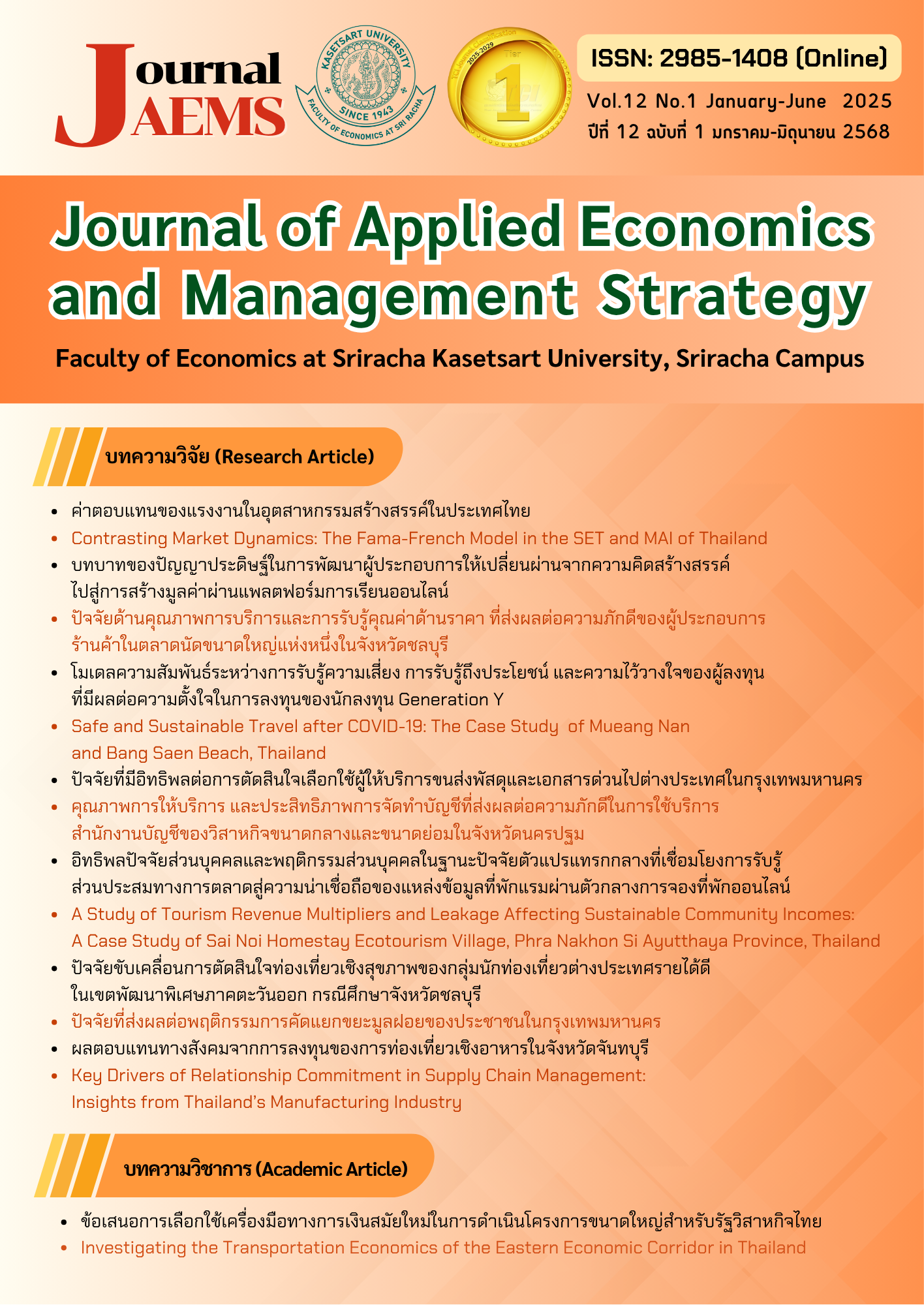Artificial Intelligence in Developing Entrepreneurs to Transition from Idea to Value Creation through Online Learning Platform
Main Article Content
Abstract
The objectives of this research were: 1) to develop a curriculum for medical tourism entrepreneurs through online platforms and artificial intelligence, 2) comparing the two teaching methods, teaching through online platform, and applying artificial intelligence in teaching, and 3) evaluate the initial Social Return on Investment (SROI) of entrepreneurial development projects. The sample group consisted of 88 people from 5 groups: 1) manufacturing industry, 2) trading industry, 3) service industry, 4) community enterprise, 5) others, using the volunteer recruitment method. The instruments used for data collection included interviews, questionnaires, and tests. Data were analyzed using statistics including percentage; mean, standard deviation, Shapiro-Wilk, One-way ANOVA and Paired-Sample t-Test. The duration of the trial course was 3 months (June–August 2024). Results of research find out that firstly, the entrepreneurship program comprised four subjects: Trends and Opportunities of Medical Tourism Business in Thailand, New Business /Product /Service Development 1, New Business/Product/Service Development 2, and Entrepreneurs 5.0 for Medical Tourism Business. Secondly, it was determined that the teaching method 2 with AI, as a result, average score of learners is higher than teaching methods 1. There was a statistically significant difference between the two teaching methods (t(87) = -14.7260, p < 0.001), with the second teaching method (M = 35.61, SD = 3.92) having the mean difference between the two teaching methods being 7.625 units (95% CI [-8.65, -6.60]). Thirdly, initial Social Return on Investment (ROI assessment showed a significant economic impact, with SROI values ranging from 85.56 to 101.56, meaning that every THB 1 invested in the project can generate social and economic returns between THB 85.56 and THB 101.56. From these research findings, it can be inferred that an entrepreneurship program developed is suitable and capable of preparing entrepreneur for the launch of a business.
Downloads
Article Details

This work is licensed under a Creative Commons Attribution-NonCommercial-NoDerivatives 4.0 International License.
References
กระทรวงศึกษาธิการ. (2565). รูปแบบการจัดการเรียนรู้ผ่านดิจิทัลแพลตฟอร์มโดยการมีส่วนร่วมของภาคเอกชน. บริษัท 21 เซ็นจูรี่.
การท่องเที่ยวแห่งประเทศไทย. (2564). รายงานฉบับสมบูรณ์ โครงการศึกษาห่วงโซ่อุปทานการท่องเที่ยวเชิงการแพทย์ (Medical Tourism) ของไทย ปี 2563. สืบค้นเมื่อ 15 มีนาคม 2567 จาก http://tourismlibrary.tat.or.th/medias/T26950.pdf
ไทยรัฐออนไลน์. (2567). ท่องเที่ยวเชิงการแพทย์' โอกาสเศรษฐกิจไทย กับความท้าทายที่ต้องเร่งปรับตัว. สืบค้นเมื่อ 20 มีนาคม 2567 จาก https://www.thairath.co.th/scoop/theissue/2756870
ธนาคารทหารไทยธนชาต. (2565). ttb analytics คาดอุตสาหกรรมการท่องเที่ยวเชิงการแพทย์ของไทยฟื้นเร็วโตเฉียด 2.5 หมื่นล้านบาทในปี 2566. สืบค้นเมื่อ 20 มีนาคม 2567 จาก https://www.ttbbank.com/th/newsroom/detail/medical-tourism-2566
พรประสิทธิ์ เด่นโมฬี (2564) การพัฒนาหลักสูตรผู้ประกอบการด้วยการเรียนผ่านออนไลน์เพื่อส่งเสริมความเป็นผู้ประกอบการของนิสิตนักศึกษาในสถาบันอุดมศึกษา. (วิทยานิพนธ์หลักสูตรปริญญาครุศาสตรดุษฎีบัณฑิต คณะครุศาสตร์ จุฬาลงกรณ์มหาวิทยาลัย).
พรประสิทธิ์ เด่นโมฬี. (2567). หลักสูตรผู้ประกอบการ 5.0, Module 3: ธุรกิจการท่องเที่ยวเชิงการแพทย์.(Power point). สืบค้นเมื่อ 1 เมษายน 2567 จาก https://www.entrepreneuronline-learning.com/18114796/module-3-ธุรกิจการท่องเที่ยวเชิงการแพทย์
วิชยาภรณ์ ระจิตร. (2557). การประยุกต์ใช้การเรียนการสอนสื่ออิเล็กทรอนิกส์. (วิทยานิพนธ์วิทยาศาสตร์มหาบัณฑิต, มหาวิทยาลัยเทคโนโลยีมหานคร).
ศรัณย์ศิริ คัมภิรานนท์. (2564). AI เทคโนโลยีอนาคตของประเทศไทย. สืบค้นเมื่อ 4 เมษายน 2567 จาก https://online.fliphtml5.com/pyepm/wcdo/
เศรษฐภูมิ บัวทอง เกศกุล สระกวี และบุญฤทธิ์ พานิชเจริญ (2564). หนังสือคู่มือการประเมินผลกระทบทางสังคมและผลตอบแทนทางสังคมจากการลงทุนโครงการเพื่อสังคมเพื่อความเข้าใจหลักการเบื้องต้นและสนับสนุนการปฎิบัติงานขององค์กรเพื่อสังคม. วิทยาลัยพัฒนศาสตร์ ป๋วย อึ๊งภากรณ์.
สุภโชค ตันพิชัย. (2566). จากการสอนแบบดั้งเดิมสู่การเรียนรู้ที่มีเทคโนโลยีเป็นเพื่อนคู่คิด: การเดินทางสู่อนาคตของการศึกษา. สืบค้นเมื่อ 4 เมษายน 2567 จาก https://li.kmutt.ac.th/from-traditional-teaching-to-technology-enabled-learning/knowledge/
Alomoto, W., Niñerola, A., & Pié, L. (2022). Social Impact Assessment: A Systematic Review of Literature. Social Indicators Research, 161, 225–250.
Atsalikorn, W., Laothamatas, J., & Prasoptham, J. (2023). Social impact and social return on investment of the potential development project for elderly care service in Mae Mok subdistrict, Thoen district, Lampang province. Kasetsart Journal of Social Sciences, 44(3), 665–674. Retrieved April 10, 2024 from https://doi.org/10.34044/j.kjss.267894
Bathla, G., Raina, A., & Rana, V. S. (2024). Artificial intelligence-driven enhancements in medical tourism: Opportunities, challenges, and future prospects. In Impact of AI and Robotics on the Medical Tourism Industry (pp. 24). Retrieved May 11, 2024 from https://doi.org/10.4018/979-8-3693-2248-2.ch006
Bentley, L. (2024). The role of technology in enhancing health and wellness tourism experiences. International Journal of Advanced Scientific Research and Innovation, 6(6), 6. Retrieved May 11, 2024 from https://doi.org/10.5281/zenodo.11403443
Bosma, N., & Kelley, D. (2018). Global Entrepreneurship Monitor: 2018/2019 Global Report. Retrieved April 7, 2024 from https://www.c4e.org.cy/reports/2019/Global_GEM_Report_2018_2019.pdf
Corvo, L., Pastore, L., Mastrodascio, M., & Cepiku, D. (2022). The social return on investment model: a systematic literature review. Meditari Accountancy Research, 30(7), 49-86. Retrieved October 5, 2024 from https://doi.org/10.1108/MEDAR-05-2021-1307
Emerson, J., Wachowicz, J., & Chun, S. (2001). Social return on investment (SROI): Exploring aspects of value creation. San Francisco, CA: Roberts Foundation.
Kaur, S., Budhraja, K., Pahuja, A., Nayyar, V., & Saluja, S. (2024). Leveraging artificial intelligence in education: Enhancing learning experience. In Ethical AI and Data Management Strategies in Marketing (pp. 140–155). IGI Global.
Liu, S., Sun, H., Zhuang, J., & Xiong, R. (2023). The Impact of E-Learning Technologies on Entrepreneurial and Sustainability Performance. Sustainability, 15(21), 15660. Retrieved July 20, 2024 from https://doi.org/10.3390/su152115660
Nicholls, J. (2017). Social return on investment-Development and convergence. Evaluation and Program Planning, 64, 127-135.
Ryzheva, N., Nefodov, D., Romanyuk, S., Marynchenko, H., & Kudla, M. (2024). Artificial Intelligence in higher education: Opportunities and challenges. Amazonia Investiga. Retrieved July 15, 2024 from https://mail.amazoniainvestiga.info
Salforest. (n.d.). Understanding SROI–Numbers that are “pleasing” but may not help make the “right” decision about social outcomes. (In Thai). Retrieved July 20, 2024, from http://salforest.com/blog/understand_sroi
Sopact. (2024). Social Return on Investment (SROI) - New Approach. Retrieved July 15, 2024 from https://www.sopact.com/guides/social-return-on-invesment-sroi
SROI Network. (2009). A guide to social return on investment. London: Society Media.
Then, V., Schober, C., Rauscher, O., & Kehl, K. (2017). Social return on investment analysis: Measuring the impact of social investment. Springer.
Wang, S., Wang, F., Zhu, Z., Wang, J., Tran, T., & Du, Z. (2024). Artificial intelligence in education: A systematic literature review. Expert Systems with Applications, 252 (Part A), 124167. Retrieved July 22, 2024 from https://doi.org/10.1016/j.eswa.2024.124167
